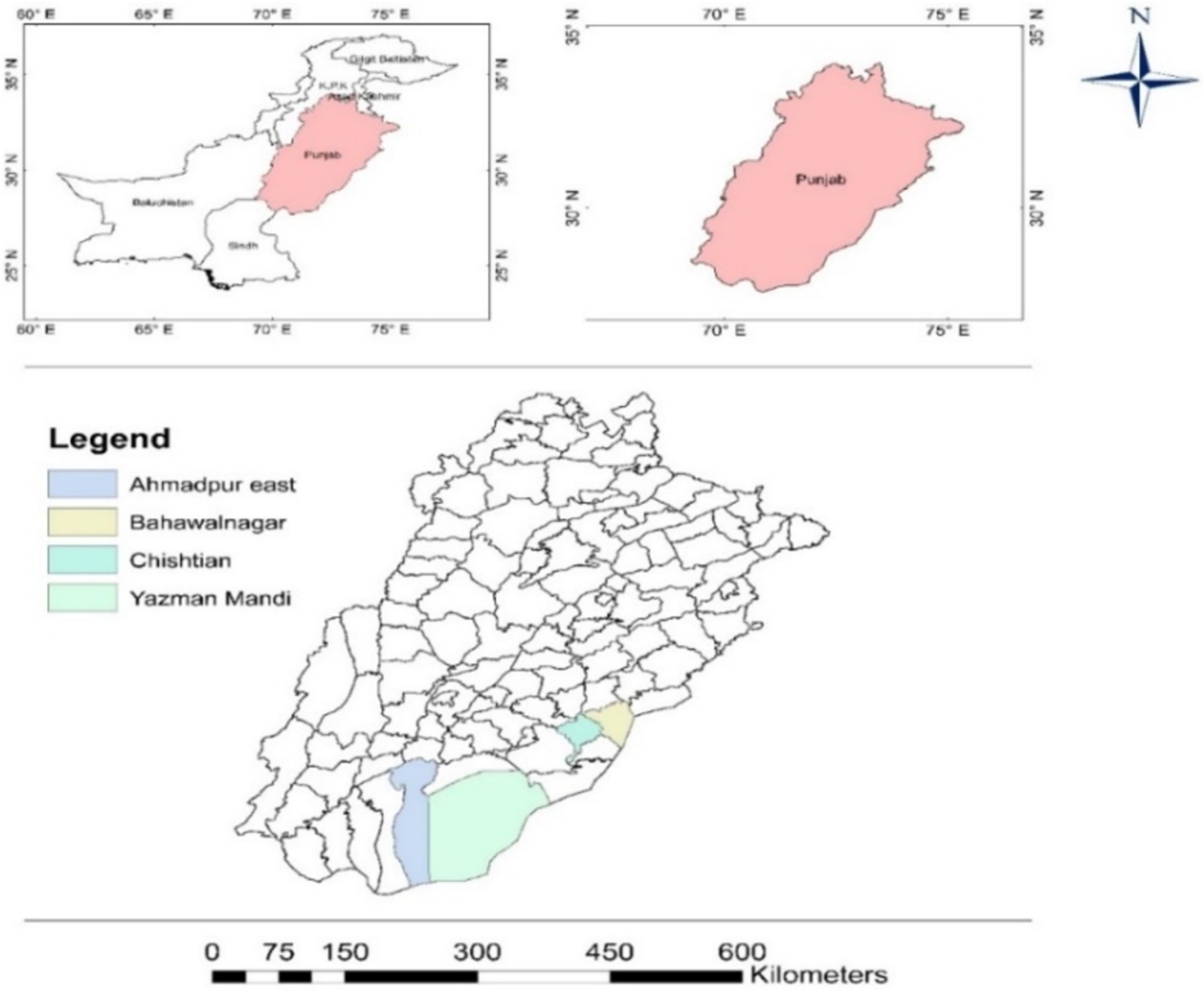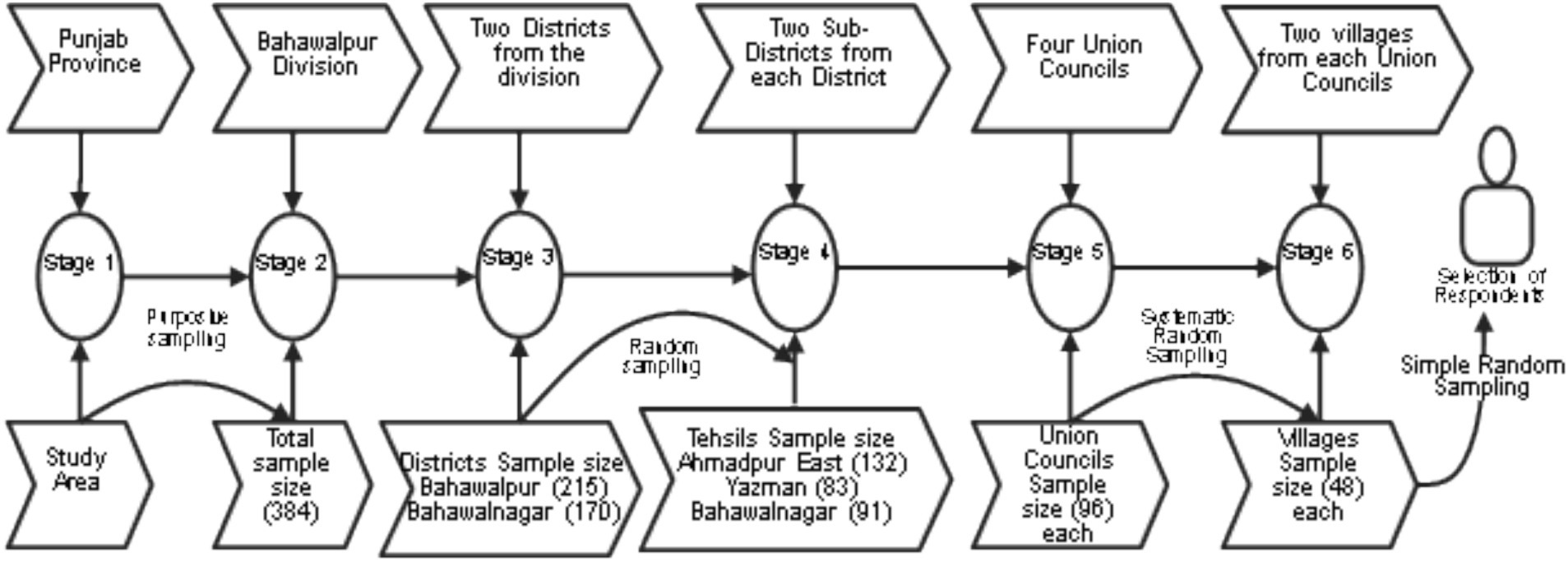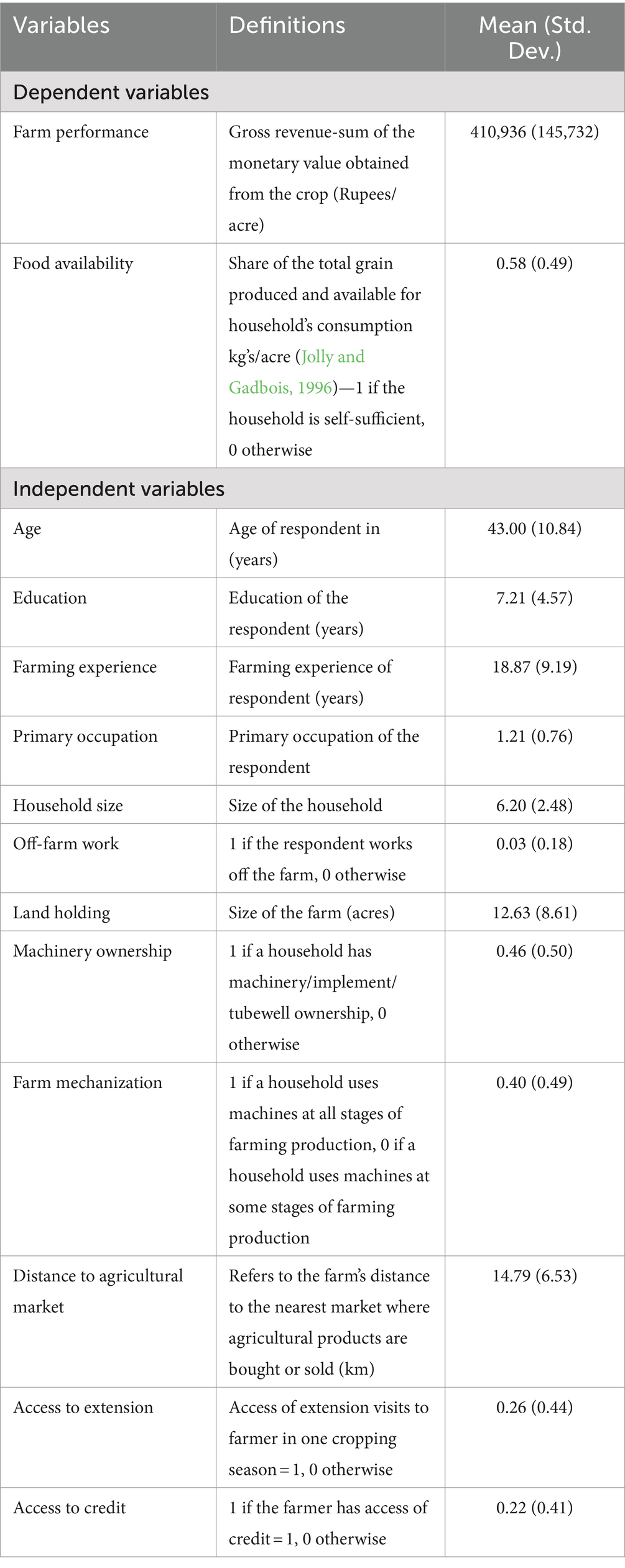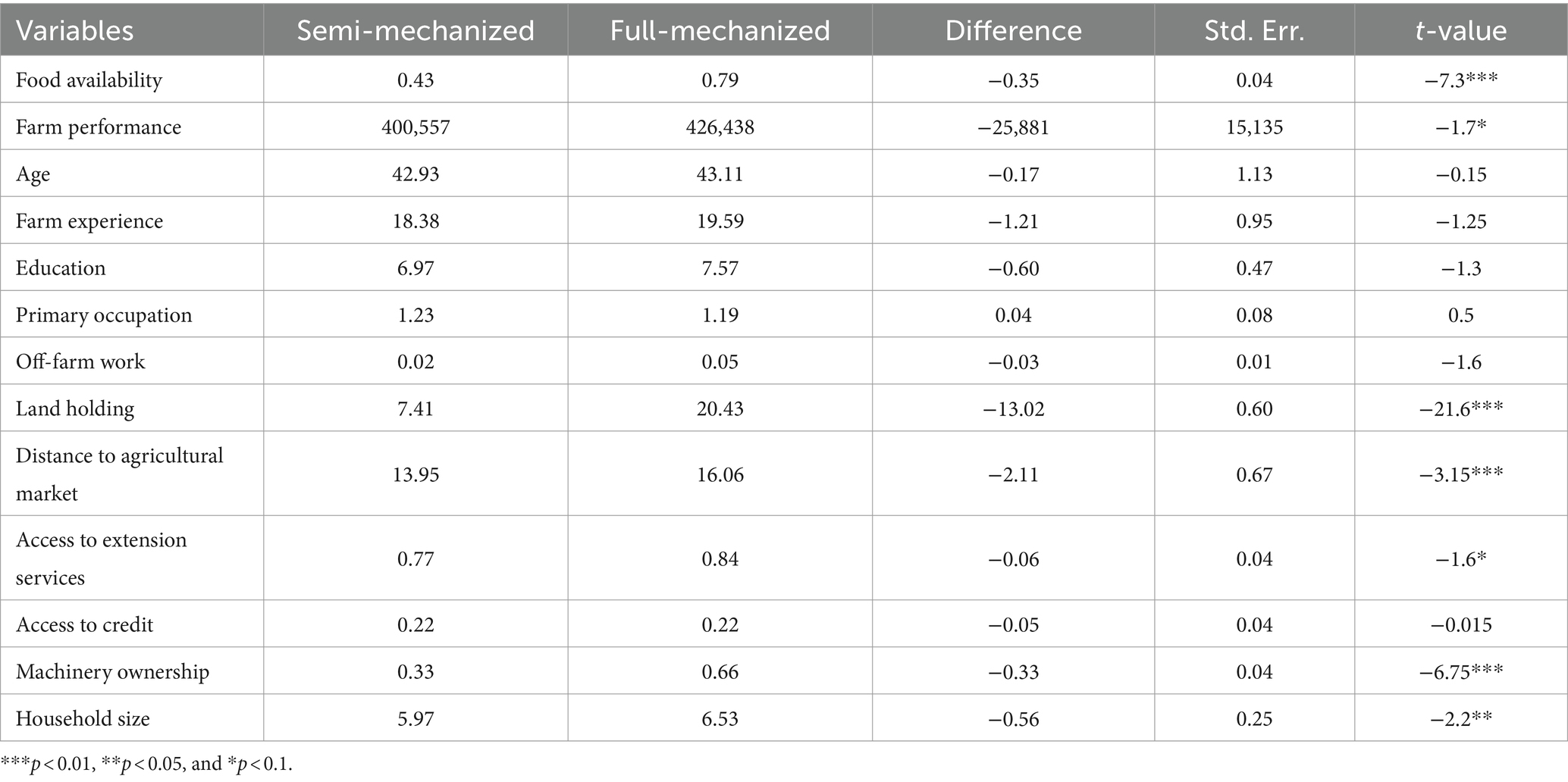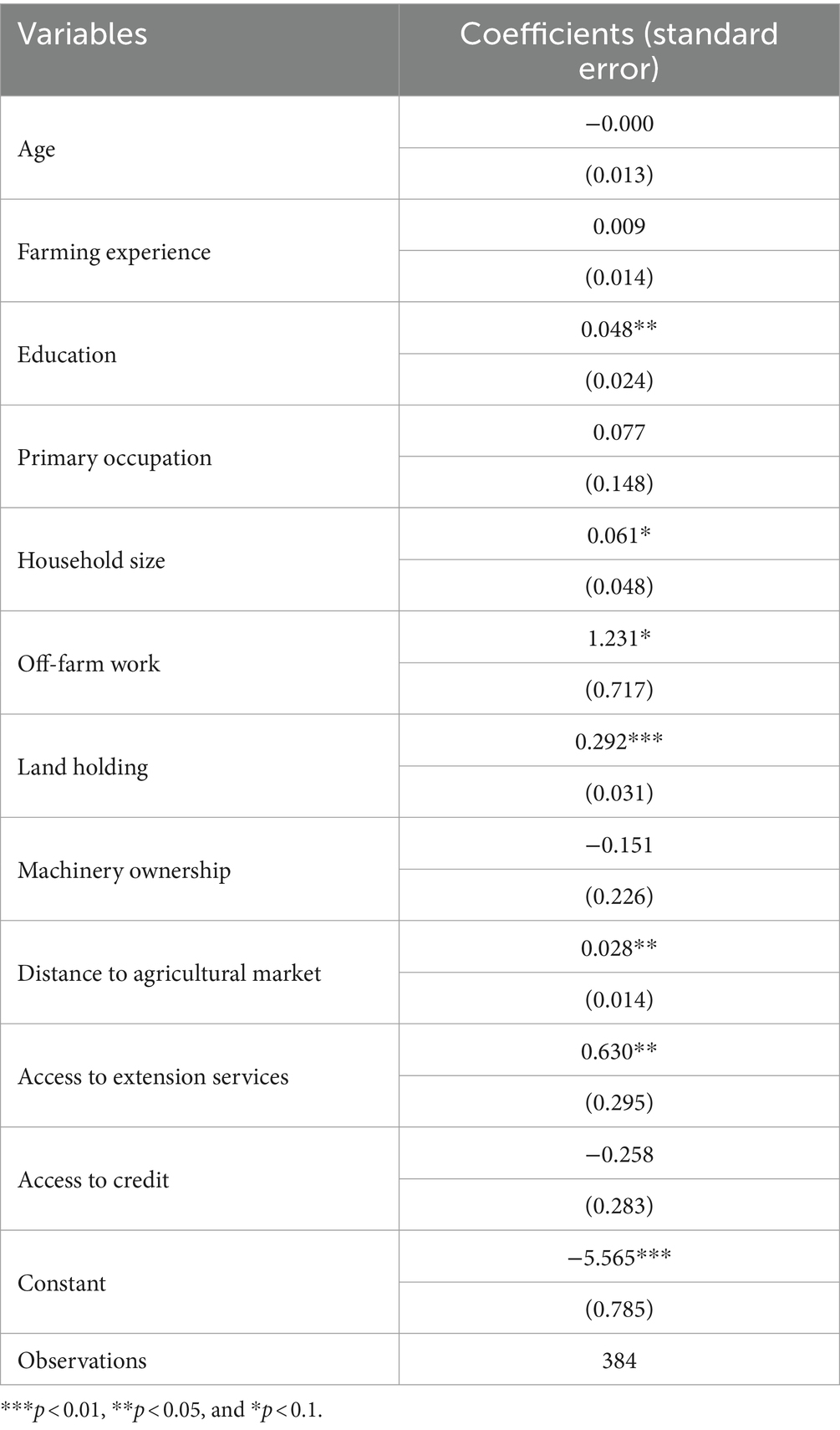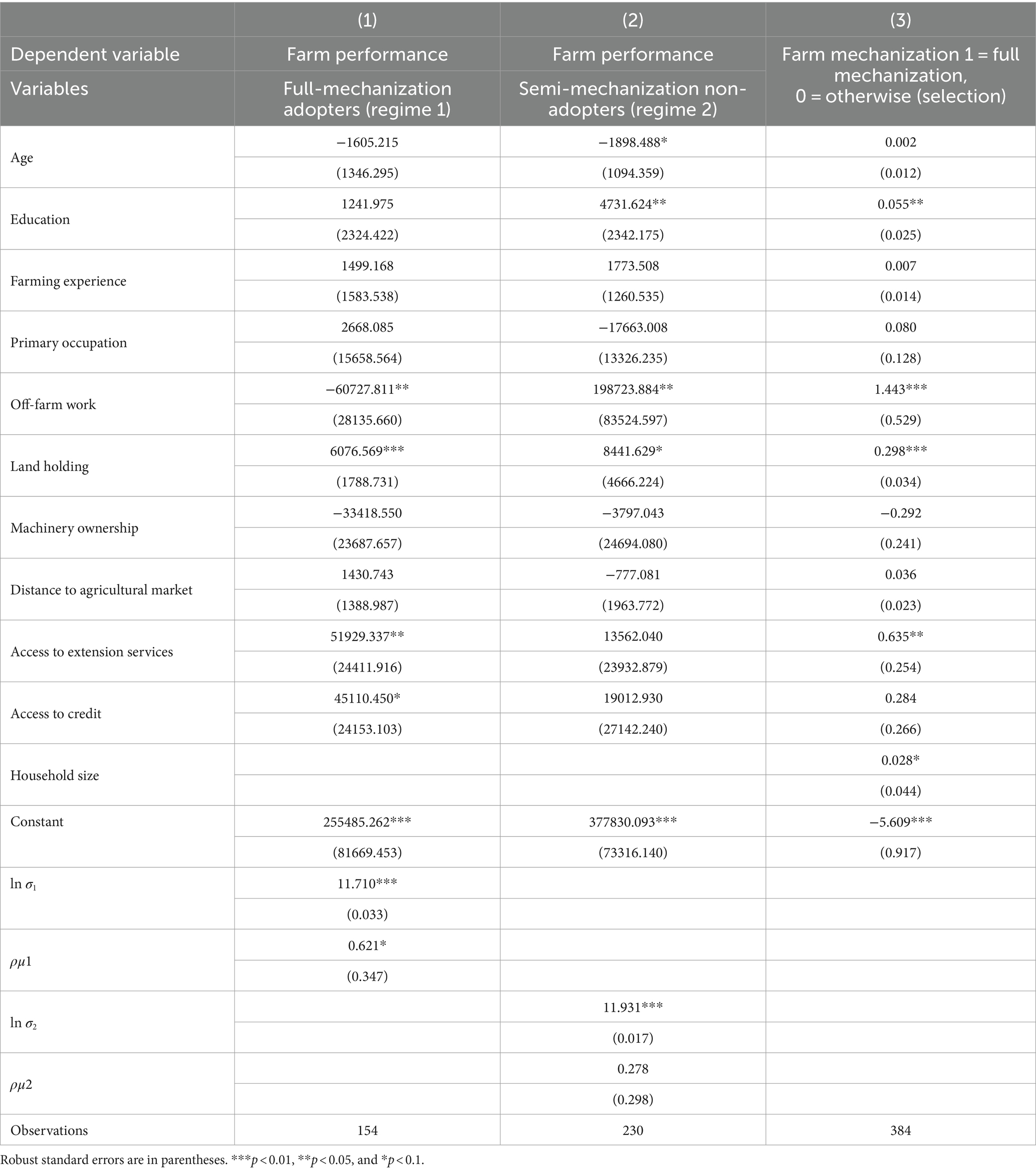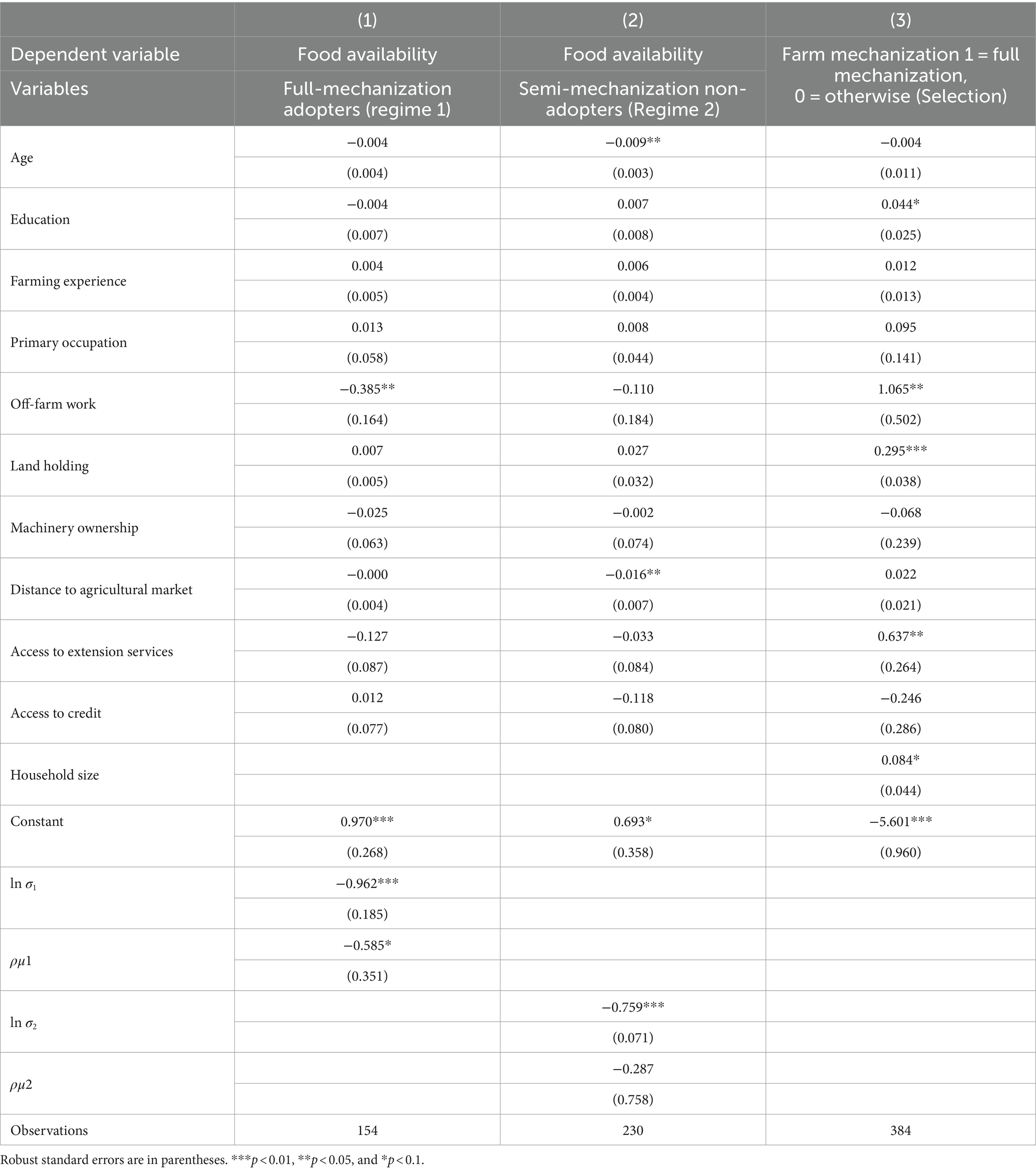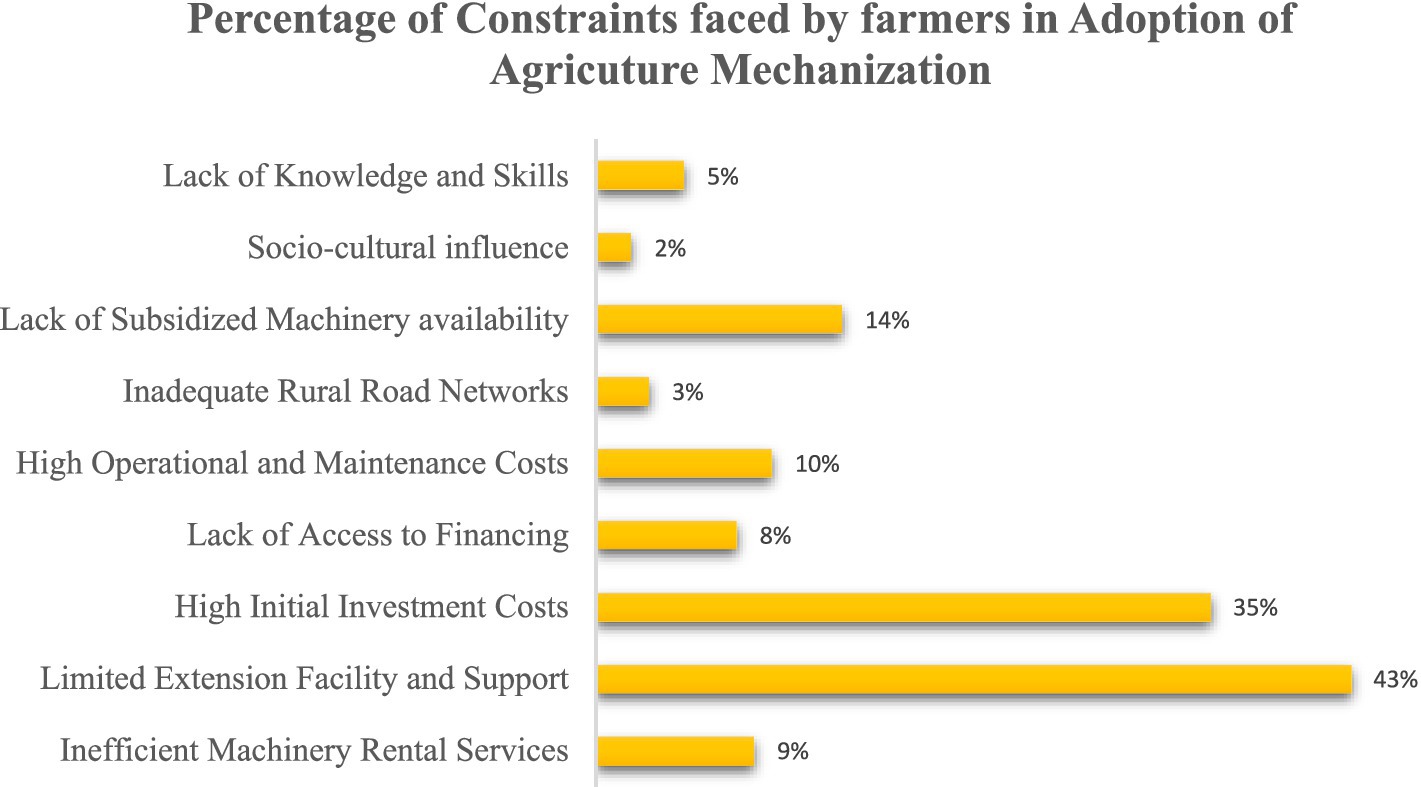- 1Department of Agricultural and Resource Economics, MNS-University of Agriculture, Multan, Pakistan
- 2Department of Agribusiness and Entrepreneurship Development, MNS-University of Agriculture, Multan, Pakistan
- 3Department of Economics, University of Mianwali, Mianwali, Pakistan
- 4College of Economics and Management, Shandong Agricultural University, Taian, China
- 5Department of Agricultural Extension and Rural Society, Faculty of Agriculture, Mansoura University, Mansoura, Egypt
- 6Plant Production Department, College of Food and Agriculture Sciences, King Saud University, Riyadh, Saudi Arabia
- 7Department of Botany, Division of Science and Technology, University of Education, Lahore, Pakistan
Agriculture has a significant role in the wellbeing of the rural households of developing countries. Still, its productivity is very low in these countries due to the low use of mechanization at the farm level. In addition, extreme climate events and labor shortages at required intervals have made decisive pitch for the promotion and adoption of farm mechanization for ensuring sustainable farm performance and food security in developing countries. However, limited empirical evidence is available from Pakistan, about the adoption of farm mechanization and its impact on farm performance and food availability. Therefore, primary data were collected from 384 farmers from cotton–wheat cropping system of Punjab, Pakistan, by using a multi-stage sampling procedure. The endogenous switching regression (ESR) model was employed to estimate the determinants of farm mechanization adoption and their associated impacts on farmers’ livelihood, measured by farm performance and food availability. The findings indicate that the adoption of full mechanization across all farming operations enhances overall farm performance and improves food availability. In addition, full mechanization leads to a substantial increase in farm performance by up to 55% and boosts food availability by approximately 125%. Our study demonstrates that the adoption of farm mechanization is strongly influenced by factors such as education, household size, landholding, off-farm employment, access to credit, and extension services.
1 Introduction
Agriculture, food, and production system reform are of paramount importance to meet global sustainability targets, while innovations can be pivotal to this transition because they involve trade-offs and sustainability synergies across social, economic, and environmental pillars. Agricultural mechanization is one such innovation that is rapidly gaining momentum in the world and is high on the agenda for policy in developing countries (Daum, 2023).
Globally, the increase in population and improved economic conditions are resulting in an escalating demand for food. In addition, the development in urban areas is causing a shift in food preferences, specifically toward cereals such as wheat and maize, which are convenient to cook but labor-intensive to produce (Diao et al., 2020). Improving farm performance is important for sustainable agricultural production, food security, better livelihood, and rural development (Adenle, 2020; Ullah et al., 2023). However, rural areas in developing countries are facing severe labor shortages due to labor migration toward urban areas. These socio-economic issues are a challenge in developing sustainable agricultural production, resource allocation, and food availability (Batool and Abdul, 2023).
However, there is strong evidence that mechanization can enhance land productivity by addressing labor shortages, thus improving agricultural farming practices such as enabling more precise seed placement and increasing fertilizer efficiency (Zhou and Ma, 2021). It also leads to an increase in the frequency of crop cultivation, promotes the use of technologies that boost yields, and minimizes crop damages and losses, leading to higher incomes and alleviation in poverty (Ullah et al., 2023). Agricultural mechanization has enabled nations worldwide to distinguish agricultural produce from agricultural labor, liberating them from the extensive physical work of farming. However, this improvement has not been uniform globally; developed economies have achieved full mechanization in their farming practices, while developing economies have made significant advancements but are still progressing in this regard (Jena and Tanti, 2023; Sang et al., 2023). These uneven advancements in mechanization can be attributed to disparities in agricultural labor productivity worldwide, which, in turn, contribute to global income inequality to some extent (Fuglie et al., 2020). Identifying the limitations and opportunities influencing farmers’ willingness to mechanize agriculture, as well as evaluating its economic implications, could provide policymakers with valuable data insights for developing effective policies.
2 Literature review
Several studies on mechanization often emphasize its capacity to enhance the economic aspects of agriculture, food, and production systems. For example, Manjulatha et al. (2021) compared the economics of mechanized and traditional maize production systems and concluded that there is a 12% savings in the mechanized system compared to the traditional systems, and net returns recovered with mechanization were 52% higher in this comparison, which exempts the myth that mechanization increases production cost. Another study, conducted in Pakistan, by Hussain et al. (2010) concluded that raised bed irrigation, which involves mechanization, has a higher benefit–cost ratio (BCR) compared to the conventional irrigation system in wheat production. For the conventional system, BCR is 2.24, while for the raised bed system, it is 2.86. Agricultural mechanization, while boosting agricultural productivity, can have significant environmental impacts. However, one of the primary concerns is the increase in greenhouse gas (GHG) emissions due to the reliance on fossil-fuel-powered machinery, such as tractors and harvesters, which contribute to carbon dioxide (CO₂) and nitrogen oxides (NO x ) emissions (Flammini et al., 2022).
Any effort to enhance agricultural output without considering effective mechanization will have less chance of success (Negrete, 2015; Zhou and Ma, 2021). Implementing mechanization in farming also enhances the ability of farm households to develop resilience to various hazards. Mechanization can enhance the ability to deal with health shocks. Without the use of machines, farming is often linked to physically demanding labor that can negatively affect one’s wellbeing and health (Olasehinde-Williams et al., 2020). Mechanization has the potential to impact the four fundamental aspects of food security: availability, accessibility, usage, and stability, as defined by the FAO (FAO, 2021). Mechanization can also aid in preventing post-harvest food losses and improving food safety (Daum, 2023). Sustainable agricultural mechanization promotes food self-sufficiency, produces economic and inclusive growth, provides social advantages, and advances the objectives of sustainable agriculture (Mrema, 2015).
In Pakistan, farm mechanization is being under-prioritized as compared to other countries due to the lack of technology and innovation in the agriculture sector. Although the government of Pakistan has taken considerable steps to enhance farm productivity through mechanization, there is still a need to fulfill the demand for tractors. The country has approximately 692,626 operational tractors, providing approximately 0.9 horsepower (HP) per acre, which falls short of the required 1.4 HP per acre. In FY2024, total tractor production rose to 36,304 units, up from 22,626 the previous year, marking a 60% increase driven by the rapid expansion of reclaimed agricultural land following recent floods. In addition, electricity and diesel costs remain among the largest expenses for farmers. To address this, Rupees 30.0 billion has been allocated to convert 50,000 agricultural tubewells to solar energy. Similarly, to address overlapping sowing and harvesting seasons caused by climate change and to prevent pre- and post-harvest losses, duties and taxes are exempted on combined harvesters, seeders, planters, and dryers (GOP, 2023).
Mechanization can have potential distributional impacts among small farm holders and laborers, and it can also improve accessibility by increasing the wages of farmers, a significant number of whom experience poverty and hunger. In addition, it can contribute to reducing production costs, which is advantageous for impoverished rural and urban households that rely on purchasing food. These households typically allocate a significant portion of their budgets, ranging from 50 to 70%, to food expenses. Unfortunately, due to financial constraints, they often struggle to afford nutritious diets. Mechanization mitigates the physical demands associated with manual farming, which include substantial energy requirements and can result in caloric energy deficiencies (de Oliveira et al., 2017; Zhou and Ma, 2021; Wu, 2022; Daum, 2023). Nevertheless, these findings lack generalization due to their limited scope in understanding the relationship between agricultural mechanization and farm performance. This limitation arises from variations in natural resource endowments, economic development conditions, crop diversification, institutional arrangements, and geographic heterogeneities. Currently, there is a limited amount of research examining the factors influencing farmers’ decisions to adopt mechanization in a multiple-choice scenario.
In this study, the existing literature has been extended to make three significant contributions. First, it analyzes the factors affecting the adoption of agriculture machinery. Farm mechanization is represented by two mutually exclusive strategies: the semi-mechanized farming strategy and the full-mechanized adoption strategy. In the current study, the semi-mechanized strategy refers to the farming pattern in which mechanization is implemented at some stage of farming, while the full mechanization strategy refers to the utilization mechanization at all farming stages (Zhou and Ma, 2021). Similarly, farming stages include land preparation, seed sowing/planting, irrigation, fertilizer and pesticide application, management, harvesting, and transportation. Second, the impact of farm mechanization adoption on farm performance and food availability is assessed. Farm performance and food availability are the primary outcomes of interest in the study. Farm performance is captured by gross revenue obtained from crops and leasing machines (Abdallah et al., 2021). Food availability is captured by a proxy indicator, self-sufficiency, which is computed as the share of the total food produced and available for households’ own consumption (Jolly and Gadbois, 1996). Third, the constraints that farmers face in adopting farm mechanization are identified. The rest of this study is organized as follows. Section 3 introduces the materials and methods data, as well as descriptive statistics. Section 4 presents the econometric strategy, while the empirical results are discussed in section 5. The final section concludes with policy implications.
3 Materials and methods
3.1 Data source and sampling framework
The data utilized in this study were obtained from an extensive survey conducted through a precisely designed questionnaire. Employing a multi-stage sampling technique, the survey gathered data from two distinct divisions, namely, Bahawalpur and Bahawalnagar. The sampling procedure employed in this study guarantees the acquisition of comprehensive data pertaining to personal- and household-level attributes. These attributes include age, education, participation in off-farm work, household size, cost of production, and agricultural aspects such as production, marketing, and access to information, procurement of loans and credit facilities, primary occupation, machinery ownership, and finally constraints to adopting mechanization. This allows us to include a rich set of variables representing from the study area.
The research survey was conducted in the Bahawalpur division, with further categorization into districts and tehsils. The selection of these areas was based on the extent of cultivation for specific crops, such as cotton and wheat, as reported in a published source of district-wise area under cultivation of different crops. A multi-stage sampling methodology was employed to ascertain a sample size of approximately 384 farmers to conduct face-to-face interviews. The random sampling technique was employed during the selection process of representative districts presented in Figure 1.
A systematic random sampling technique was employed to select two sub-districts (tehsils) and eight villages from each district. In the selection process, a simple random sampling technique was employed to choose approximately 50 farmers from each village as shown in Figure 2.
The responses provided by the respondents were cross-validated through key informant interviews prior to the completion of the final field observation. A standardized procedure is employed guaranteeing the absence of any personally identifiable information, with the exception of the village name and the serial number assigned to the questionnaire. The interviews have been conducted with farmers to collect data on socio-economic factors, demographic characteristics, and information pertaining to mechanization in agriculture, including the costs associated with adopting agricultural mechanization. The determination of the sample size is conducted utilizing Cochran’s formula, as outlined by Uakarn et al. (2021) in Equation 1.
where 𝑛 is the sample size, 𝑝 is the population proportion (𝑝 = 0.1), and 𝑒 is the acceptable sampling error (𝑒 = 0.05).
Since each tehsil has a different population, the sample size was selected in proportion to the population of each tehsil. This proportionate distribution of the sampled data across various strata is achievable through proportional allocation (Rajpar and Barrett, 2019). Using the following formula, the sample size at the tehsil level is calculated in Equation 2:
where 𝑛𝑖 is the sample size for the ith stratum, n is the sample size of the entire population (384 in this case), N𝑖 denotes the total number of rural households (farmers) in the ith stratum, and N is the total number of rural households in all three strata.
4 Econometric approach
4.1 Farmers’ adoption of mechanization strategies
Farmers choose different mechanization strategies in farm production based on household- and farm-level characteristics, as well as various socio-economic factors. This self-selection process creates a sample selection bias related to the mechanization adoption variable, which must be addressed to accurately estimate the effects of agricultural mechanization on farm performance and food availability. The decision to adopt an agricultural mechanization strategy is taken as a binary choice, where farmers must decide between two distinct strategies: full mechanization or semi-mechanization. This decision is influenced by different variables. The adoption choice is formulated under a random utility framework (Raza et al., 2022). Farmers mostly make their selections on a comparison of their anticipated utilities in this scenario ( and ) obtained from their farm performance and food availability by adopting mechanization strategies (semi-mechanized and full-mechanized), respectively. Let the difference in the expected utility be represented by , farmer will adopt full mechanization if . However, the utility difference ( ) is unobservable but can be specified as a function of observable factors in a latent variable framework as follows in Equation 3:
where is a binary decision indicator, which equals one if farmer adopts full mechanization strategy in farming and zero in case of semi-mechanization; denotes a set of unknown parameters to be estimated; denotes observable factors. These include education, household size, farm size, off-farm work, farm size, access to credit, and extension visits. is the error term. A farmer’s probability of adopting one of two mutually exclusive mechanization strategies is specified in Equation 4:
where represents the cumulative distribution function for .
When encountered with a choice between adopting a technology and not adopting it, researchers have used non-parametric approaches such as propensity score matching to address the issue of selection bias and estimate the effects of policy programs or interventions related to technology adoption. Selection bias is likely to occur in impact evaluation research if the intervention is not implemented using a randomization procedure (Eriksen, 2018). Economic agents self-select into the intervention due to a variety of pre-existing factors, some of which are observable and others of which are not. This leads to biasness in the outcome, for instance, whether the farmer household uses mechanized farming because it is not determined at random by whether or not they own agricultural machinery. Rather, a number of variables affect how a farmer adjusts to mechanization in farming. It is possible that some of these factors that have not been noticed yet and that they have a correlation with the outcome variable that our impact evaluation is meant to evaluate. Such unobservable variables may interfere with the accurate impact assessment of the intervention. Usually, regression estimations would miss the self-selection caused by the observations preceding endogeneity. As a result, there will be misleading standard errors and ineffective slope coefficients. This study models the effects of adopting two agricultural mechanization technologies on farm performance and food availability within an ESR framework. The ESR, in comparison with the PSM model, is a relatively new methodology for correcting selectivity that offers three advantages: (a) It can address selection bias arising from both observable and unobservable factors; (b) it allows for the identification of factors that influence farmers’ decisions to adopt mechanization strategies and factors that impact the farm performance and food availability as followed by previous studies (Di Falco et al., 2011; Kassie et al., 2017; Kumar et al., 2018).
4.2 Endogenous switching regression
Distinguishing between full-mechanized adopters and semi-mechanized adopters can lead to significant variations in results, which can be attributed to both observable and unobservable factors. Hence, the endogenous switching regression (ESR) is utilized to address the influence of both observable and unobservable endogeneity in the adoption decision. This involves estimating the adoption function and the outcome equation separately for each group. Based on the studies conducted by Shiferaw et al. (2014), the ESR can be calculated using the following method:
The equation consists of two dependent variables, namely, ( ) and ( ), which reflect outcomes for full mechanization adopters in Equation 5 and semi-mechanized adopters in Equation 6, respectively. is a matrix of explanatory factors, is a vector of parameters to be estimated, and and are error terms. The error factors , , and in the three equations are assumed to follow a trivariate normal distribution. This distribution has a mean vector of zero and a covariance matrix as follows in Equation 7:
The value of represents the variance of the selection equation. and represent the variances of the result equations for semi-mechanized adopters and full mechanization adopters, respectively. and indicate the covariance between and . If ε is associated with both and , then the predicted values of and , given the sample selection, are not equal to zero.
In Equations 8 and 9 ϕ represents the probability density, and ϕ represents the cumulative distribution function of the standard normal distribution. If the statistical significance of and is observed, it implies that there is a correlation between the choice to adopt full mechanization and the outcome variable of interest. This correlation suggests the presence of sample selection bias. Consequently, using ordinary least squares (OLS) to estimate the outcome equations would result in skewed and inconsistent findings. Therefore, it is a common practice to employ Heckman techniques (Heckman, 1979). The full information maximum likelihood (FILM) estimator may be employed to fit an endogenous switching regression in the presence of heteroscedastic error components. This estimator allows for the simultaneous estimation of the selection and outcome equations, resulting in consistent results. The ESR can be utilized to evaluate the real anticipated results of fully mechanized adopters (Equation 10) and semi-mechanized adopters (Equation 11), as well as to examine the hypothetical scenarios in which the semi-mechanized adopters did adopt (Equation 12) and the full-mechanized adopters did not adopt (Equation 13) as outlined below:
Ultimately, the average treatment impact on the treated (ATT) is obtained by subtracting Equation 10 from Equation 13 and the average treatment effect on the semi-mechanized adopters (ATU) by subtracting Equation 12 from Equation 11.
Several variables including the types of crops cultivated, and the quantities of fertilizers, seeds, labor, and tillage employed have a crucial role in determining crop production. This, in turn, has a direct impact on farm performance and food availability. In addition, the extent to which farmers engaged in hosting demonstration trials, attending field days, or both, might influence their decisions to adopt different mechanization strategies as these factors are taken into account while estimating the ESR. It is required that ESR is properly estimated as the set of observable factors overlaps during estimation. It is required that the ESR model is properly identified since the set of factors in that are observable determining outcome overlap during estimation. In doing so, at least one variable called an instrument in the explanatory variable will not be featured in observable factors determining the outcome. The identification involves including one or more valid instruments in the selection equation before estimation. Confirming the validity of the instrumental variable, household size has been identified as the instrument. It is argued that the larger household sizes lead to the adoption of a mechanization strategy. The employed instrument is significant in the selection equation but not the outcome equation.
5 Results and discussion
5.1 Descriptive statistics
Table 1 presents a thorough summary of the variables analyzed in a research study. The outcome of interest is farm performance and food availability. The average farm performance as assessed by gross revenue per acre is an average of 410,963 Rupees/acre. Approximately, 40% of the farmers in the representative sample are full mechanization adopters, and 60% are semi-mechanized, respectively. The food availability, which represents the proportion of total grain produced that is accessible for household use, has an average value of 0.58 which depicts that 58% of the households are self-sufficient in food production. The demographic features of the respondents serve as independent variables, providing a socio-economic backdrop.
The respondents had an average age of 43 years with an education level of 7 years and an average farming experience of 19 years. These factors have the potential to impact decision-making, resource allocation, and overall agricultural output. The primary occupation refers to the primary occupation of the respondent; 91% of the respondents have the primary occupation of farming. The average number of people residing is 6 in a household; on average, 3% of the households are engaged in off-farm work. The landholding was captured as farm size in acres, and the average land holding is 13 acres. On average 46% of the households have their own machinery, tubewell, and tillage implements. Distance to the agriculture market was nearly 14 km from the farm on average. Approximately 26% of the farmers have extension services, and only 22% of the households have access to credit facilities.
5.2 Determinants of mechanization adoption
Table 2 shows the mean differences of the variables based on the adoption decision of agricultural mechanization. The last column displays the t-value and associated statistical significances to assess whether the means of the variables in the two mechanization strategies are equal, specifically differentiating between full mechanization (adopters) and semi-mechanization (non-adopters). The typical sample consists of 40% fully mechanized adopters and 60% semi-mechanized non-adopters. The results show that changing from semi-mechanized farming to full-mechanized farming led to an increase in farm performance from 315,768 to 364,920 rupees per acre, respectively. There is a statistically significant difference between the groups at the 1% significance level. Food availability, as captured by a proxy indicator self-sufficiency in food production, is 35% higher in full mechanization adopters, and this difference is also statistically significant at the 1% level.
Age has a notable impact on the adoption of mechanization, indicating that younger farmers are more inclined to adopt a fully mechanized approach, possibly due to their greater interest in adopting mechanization in farming operations. Farmers who adopt full-mechanized farming are more likely to have received a formal education compared to those who adopt semi-mechanized farming. Well-educated farmers can make informed judgments and adapt efficiently to enhanced farm performance and self-sufficiency in food. Farmers with bigger household sizes are more likely to adopt a full mechanization strategy, as shown by the positive and significant coefficient. Access to credit significantly influences farmers’ decisions to pursue the complete mechanized method. Specifically, 46% of the farmers are fully mechanized and have improved access to credit for farming.
Land holding has a strong and significant impact on the adoption of mechanization, suggesting that working on larger farm size increases the likelihood of adopting a full-mechanized strategy in all agricultural farming operations. This study indicates that there are considerable similarities in agricultural experience, extension services, machinery ownership, and primary occupation among the groups. The difference in distance to the agricultural market is statistically significant at the 5% level. Generally, the results in Table 2 indicate significant differences in observed characteristics between semi-mechanized farming and full-mechanized farming adopters. The findings suggest there may be selection bias linked to the voluntary adoption of different agricultural mechanization strategies. This limitation has been addressed in the endogenous switching regression model results in Tables 3, 4.
5.3 Factors influencing mechanization adoption
To empirically analyze the factors affecting the adoption of agriculture machinery, the following probit regression interpreting coefficients are as follows:
where p is the probability of adopting mechanization (either semi-mechanized or full-mechanized), or the presence of an outcome. x₁ and x₂ are the predictor variables, and β0, β1, and βn are real constants, each of which determines the emphasis x₁ and x₂ have on the outcome Y.
These results in Table 3 indicate numerous significant findings. The age of farmers impacts the decision-making process of adopting mechanization strategy. This decision is primarily influenced by factors such as economic considerations, farm characteristics, technological accessibility, and generational shifts in attitudes toward mechanization. The adoption of complete mechanization is significantly positively correlated with education. The findings indicate that for every one-unit increase in education, there is a 39% rise in the adoption of full mechanization. These findings indicate that farmers with greater levels of formal education are more likely to be aware of the benefits of adopting mechanization at each stage of the agricultural process. This is supported by the studies (Negrete, 2015; Huan et al., 2022) provided.
The use of farm mechanization is positively correlated with household size and off-farm work. These findings suggest that households with more members and those that work outside of farming are more likely to adopt the full mechanization, with adoption rates of up to 54 and 3%, respectively (Aryal et al., 2021; Jena and Tanti, 2023). Land ownership, availability of extension services, and access to credit are identified as important factors that strongly influence the likelihood of adopting a comprehensive mechanization strategy. Specifically, individuals who possess larger land holdings and have better access to extension services are more likely to adopt this strategy (Oladipupo, 2012; Negrete, 2015; Kirui, 2019; Chaiya et al., 2023).
5.4 Determinants of farm performance
This section examines the determinants of farm performance for semi-mechanization (non-adopters) and full mechanization (adopters). This forms the second stage of FIML estimation of the ESR model, and the results are reported in Table 3. The correlation coefficient (ρμ1) (lower part of Table 4) for the adopters in the farm performance equation suggests the presence of selectivity bias associated with unobservable factors. The presence of the unobservable selectivity bias justifies the use of the ESR model in the estimations. In addition, the likelihood ratio test of joint independence of the farm mechanization adoption equation and household income equation reveals that both equations are dependent.
The age variable suggests that for each additional year for age, the farm performance decreases in both strategies, i.e., full and semi-mechanized, but in case of full mechanization, it is 45% less than their counterfactual. This indicates that older farmers face challenges such as resistance to the adoption mechanization strategy and rely on traditional practices. Similarly, education has a substantial impact showing that each additional year of education causes an increase in the adoption of both mechanization strategies. Farmers with higher levels of education tend to have higher farm performance likely due to a better understanding of modern farming operations (Oladipupo, 2012). The farming experience is negative but statistically significant. This indicates that there is no clear relationship between farming experience and farm performance (Durrani et al., 2021). Farmers whose primary occupation is farming are mostly full mechanization adopters, and those whose primary occupation other than farming is semi-mechanization non-adopters tend to have significantly lower farm performance. The household size is positive and statistically significant. This indicates that larger household sizes are associated with higher levels of farm mechanization. The off-farm work has a positive impact that farmers engaged in off-farm work tend to have significantly higher farm performance (Peng et al., 2022).
The land holding is positive and highly statistically significant, and larger land holdings are associated with higher farm performance. The coefficient for machinery ownership is negative but not statistically significant. This suggests that there is no clear relationship between machinery ownership and farm performance, as mostly avail rental services to utilize mechanization at every stage of farming operations. The distance to agriculture market implies that farmers located closer to agriculture markets tend to have higher farm performance (Zerssa et al., 2023). The access to extension services indicates that farmers with better access to extension services tend to have higher farm performance. The access to credit is positive and statistically significant. This suggests that farmers with better access to credit tend to have higher farm performance.
5.5 Determinants of food availability
Table 5 illustrates the factors that influence the availability of food. Several characteristics exert a substantial influence on the group of individuals who fully adopt farm mechanization. Education is found to be a significant determinant as a 1% increase in education is linked to a 24% greater probability of complete adoption. The primary occupation indicates that those engaged primarily in farming are less inclined to adopt food availability. The provision of extension services has a significant beneficial effect, underscoring the significance of support services in facilitating the adoption of agricultural mechanization.
For those who adopt full mechanization strategy, the influence of education is minor; however, the major occupation and off-farm employment indicating that those primarily involved in farming or off-farm labor are less inclined to semi-adopt mechanization. Notably, possessing equipment has a substantial beneficial impact, suggesting that owning machinery enhances the probability of partial adoption. When it comes to the availability of food among those who fully adopt a certain lifestyle or practice, the age factor has a negligible influence. Education has a beneficial impact since it correlates with a 0.2% rise in food availability for every 1% increase in education. The coefficients for primary occupation and off-farm labor remain negative, indicating that those primarily involved in farming or off-farm work may encounter difficulties in assuring food supply (Barman et al., 2019). Food availability is minimally affected by the age variable for semi-adopters. The impact of education on food availability among semi-adopters is minimal and does not have a significant negative effect. However, primary occupation and off-farm employment have negative coefficients, indicating that these characteristics may lead to a decrease in food availability (Daum, 2023).
6 Robustness checks
The results of average treatment effects on the treated (ATT), which measure the potential impacts of mechanization adoption on farm performance food availability, are presented in Table 6. Note that the selectivity bias due to observable and unobservable factors is considered in estimating the ATTs.

Table 6. Impact of farm mechanization on farm performance and food availability: ESR model estimates.
The results show that the adoption of full mechanization significantly increases farmers’ welfare by enhancing farm performance and food availability. Specifically, farmers who adopted full mechanization gained 55% more farm performance, compared to counterpart semi-mechanization adopters. Similarly, full mechanization adoption can significantly increase food availability by approximately 125%, compared to a situation if these farmers did not adopt. These findings are in line with previous studies in developing countries that smallholder farmers observe significant benefits from mechanization adoption in the form of increased welfare. Similarly, the results presented in Table 7 are estimates from the PSM model which have less mean outcomes as compared to ESR which shows that the ESR model accounts for both observable and non-observable factors.

Table 7. Impacts of farm mechanization on farm performance and food availability: PSM model estimates.
7 Constraints in the adoption of mechanization
Major constraints faced in the study area along with their percentages are as follows: (see Figure 3).
A total of 9% of the respondents reported that they perceived the machinery rental service to be inefficient. It has been asserted that there is a noticeable increase in the prices of rented machines during the season, accompanied by a lack of effective machinery servicing. The provision of high initial investment cost constitutes of approximately 35% of the overall framework poses a significant financial burden. The initial investment costs encompass the acquisition expenses associated with machinery, such as tractors, harvesters, seeders, irrigation systems, and other equipment that are indispensable for agricultural operations (Oladipupo, 2012; Jayne et al., 2019).
Lack of access to financing for agriculture machinery denotes the limitation experienced by farmers up to 8%. The absence of sufficient access to financial resources for agricultural machinery poses a significant obstacle to the progress and modernization of the agricultural industry (Kapari et al., 2023). One of the primary challenges faced by farmers is the issue of high operational and maintenance costs, which account for approximately 10% of their overall expenses. The high operational and maintenance costs of agricultural machinery pertain to the expenditures related to the utilization and upkeep of farming equipment. The insufficient rural road networks (3%) pertain to the insufficiency of rural road networks in facilitating the transportation of agricultural machinery. The availability of subsidized machinery is constrained at a rate of 12% (Yi et al., 2019). Machinery subsidies encompass a variety of forms, including financial incentives, low-interest loans, tax exemptions, and the direct provision of machinery at reduced prices. The impact of socio-cultural factors on individuals and communities is a topic of significant academic interest, accounting for 2%. The main constraint is insufficient knowledge and skills, accounting for 5%. This constraint arises from their limited comprehension and proficiency in the operation and maintenance of agricultural machinery (Huan et al., 2022).
8 Conclusion and policy recommendations
Agricultural mechanization plays a crucial role in connecting rural families with modern agriculture. It is imperative to investigate whether the rapid expansion of farm mechanization contributes to the overall prosperity of rural areas. This research utilized the endogenous switching regression method to investigate the relationship between agriculture mechanization, farm performance, and food availability, based on the primary cross-sectional data. The study concludes that full farm mechanization adoption has a beneficial impact on farm performance and food availability of rural households across various covariates. However, there are notable differences in the extent to which farm mechanization is adopted, i.e., semi-mechanized and full-mechanized. The results show that adopting full mechanization significantly affects farm performance by up to 55%. Furthermore, full mechanization adoption effectively increased the self-sufficiency of farmers by 125% in food production. The factors influencing mechanization adoption are also addressed: Large land holdings, access to formal education, extension services, and credit facilities increase the likelihood of adopting mechanization strategies. Finally, the constraints in the adoption of mechanization are also highlighted in the study, which shows that farmers face challenges such as a lack of subsidized machinery, extension and rental services, and high initial investment costs.
To enhance the impact of farm mechanization in boosting the farm performance of rural households and narrowing the income disparity and overcome the socio-economic constraints between them, it is necessary to implement policies that aim to overcome the obstacles that impede the adoption of mechanization in rural areas.
• Governmental and non-governmental organizations should continue enhancing the development of the agricultural socialized service system and creating favorable policy conditions to improve access to and the quality of mechanization services in a timely manner.
• The adoption of fully mechanized farming has been positively and significantly influenced by variables including access to extension services, subsidies, education, and machinery services. These findings suggest that government initiatives aimed at easing farm households’ financial burdens by enhancing subsidies, promoting the growth of machinery service markets, and educating farmers about mechanization adoption at the regional level may increase the adoption of agricultural machinery by farmers, thereby boosting farm performance and food availability.
• The widely held view that machinery farming is best suited for large landholdings needs to shift. The development of scale-appropriate machinery including micro-cultivators, mini combine harvesters with 10–20 horsepower, for small-scale, fragmented landholdings in rural areas needs to be investigated for effective utilization.
8.1 Limitations and future thrust
The study focuses on a specific region in Punjab, Pakistan, particularly on labor-intensive crops, i.e., cotton and wheat. The study relies on cross-sectional data, which limits its ability to establish causal relationships. Panel data would allow for a more robust analysis of the dynamic effects of adopting mechanization. However, due to a lack of relevant data availability, the present study is unable to capture these aspects. Future studies can also analyze how the intensive use of mechanization can affect environmental performance, soil ecosystems, and health.
Data availability statement
The raw data supporting the conclusions of this article will be made available by the authors, without undue reservation.
Ethics statement
Ethical review and approval was not required for the study on human participants in accordance with the local legislation and institutional requirements. Written informed consent from the patients/participants or patients/participants legal guardian/next of kin was not required to participate in this study in accordance with the national legislation and the institutional requirements.
Author contributions
HY: Methodology, Project administration, Resources, Software, Supervision, Validation, Visualization, Writing – original draft, Writing – review & editing, Conceptualization, Data curation, Formal analysis, Funding acquisition, Investigation. MR: Conceptualization, Data curation, Formal analysis, Funding acquisition, Investigation, Methodology, Project administration, Resources, Software, Supervision, Validation, Visualization, Writing – original draft, Writing – review & editing. MF: Conceptualization, Data curation, Formal analysis, Funding acquisition, Investigation, Methodology, Project administration, Resources, Software, Supervision, Validation, Visualization, Writing – original draft, Writing – review & editing. NN: Conceptualization, Data curation, Formal analysis, Funding acquisition, Investigation, Methodology, Project administration, Resources, Software, Supervision, Validation, Visualization, Writing – original draft, Writing – review & editing. NK: Conceptualization, Data curation, Formal analysis, Funding acquisition, Investigation, Methodology, Project administration, Resources, Software, Supervision, Validation, Visualization, Writing – original draft, Writing – review & editing. HK: Conceptualization, Data curation, Formal analysis, Funding acquisition, Investigation, Methodology, Project administration, Resources, Software, Supervision, Validation, Visualization, Writing – original draft, Writing – review & editing. KE: Conceptualization, Data curation, Formal analysis, Funding acquisition, Investigation, Methodology, Project administration, Resources, Software, Supervision, Validation, Visualization, Writing – original draft, Writing – review & editing. SM: Funding acquisition, Methodology, Resources, Software, Validation, Visualization, Writing – review & editing.
Funding
The author(s) declare that financial support was received for the research, authorship, and/or publication of this article. This research was supported by the Researchers Supporting Project (RSPD2024R952), King Saud University, Riyadh, Saudi Arabia.
Conflict of interest
The authors declare that the research was conducted in the absence of any commercial or financial relationships that could be construed as a potential conflict of interest.
Publisher’s note
All claims expressed in this article are solely those of the authors and do not necessarily represent those of their affiliated organizations, or those of the publisher, the editors and the reviewers. Any product that may be evaluated in this article, or claim that may be made by its manufacturer, is not guaranteed or endorsed by the publisher.
Supplementary material
The Supplementary material for this article can be found online at: https://www.frontiersin.org/articles/10.3389/fsufs.2024.1453221/full#supplementary-material
References
Abdallah, A. H., Abdul-Rahaman, A., and Issahaku, G. (2021). Sustainable agricultural practices, farm income and food security among rural households in Africa. Environ. Dev. Sustain. 23, 17668–17701. doi: 10.1007/s10668-021-01407-y
Adenle, A. A. (2020). Assessment of solar energy technologies in Africa-opportunities and challenges in meeting the 2030 agenda and sustainable development goals. Energy Policy 137:111180. doi: 10.1016/j.enpol.2019.111180
Aryal, J. P., Rahut, D. B., Thapa, G., and Simtowe, F. (2021). Mechanisation of small-scale farms in South Asia: Empirical evidence derived from farm households survey. Technol. Soc. 65: 101591.
Barman, S., Deka, N., and Deka, P. (2019). Factors affecting farm mechanization—a case study in Assam, India. Asian J. Agric. Ext. Econ. Sociol. 32, 1–7. doi: 10.9734/ajaees/2019/v32i130146
Batool, Z., and Abdul, A. (2023). Exploring the effects of farm mechanization, financial development, and renewable energy on China’s food production. Environ. Dev. Sustain. 26, 18883–18902. doi: 10.1007/s10668-023-03419-2
Chaiya, C., Sikandar, S., Pinthong, P., Saqib, S. E., and Ali, N. (2023). The impact of formal agricultural credit on farm productivity and its utilization in Khyber Pakhtunkhwa, Pakistan. Sustain. 15.
Daum, T. (2023). Mechanization and sustainable agri-food system transformation in the Global South. A review. Agron. Sustain. Dev. 43:16. doi: 10.1007/s13593-023-00868-x
de Oliveira, S. N., de Carvalho Júnior, O. A., Gomes, R. A. T., Guimarães, R. F., and McManus, C. M. (2017). Landscape-fragmentation change due to recent agricultural expansion in the Brazilian Savanna, Western Bahia, Brazil. Reg. Environ. Change 17, 411–423. doi: 10.1007/s10113-016-0960-0
Di Falco, S., Veronesi, M., and Yesuf, M. (2011). Does adaptation to climate change provide food security? A micro-perspective from Ethiopia. Am. J. Agric. Econ. 93, 829–846. doi: 10.1093/ajae/aar006
Diao, X., Takeshima, H., and Zhang, X. (2020). An evolving paradigm of agricultural mechanization development - how much can Africa learn from Asia? Washington, DC: International Food Policy Research Institute, 548.
Durrani, S. U., Basit, A., and Ullah, I. (2021). Challenges and prospects of farm mechanization in Pakistan: a case study of rural farmers in district Peshawar Khyber Pakhtunkhwa. Sarhad J. Agric. 37, 167–179. doi: 10.17582/journal.sja/2021/37.1.167.179
Eriksen, S. (2018). Impact evaluations, bias, and bias reduction: non-experimental methods, and their identification strategies. Groningen: University of Groningen, SOM Research School.
FAO. (2021). The State of Food and Agriculture 2021. Making agrifood systems more resilient to shocks and stresses. Rome.
Flammini, A., Pan, X., Tubiello, F. N., Qiu, S. Y., Rocha Souza, L., Quadrelli, R., et al. (2022). Emissions of greenhouse gases from energy use in agriculture, forestry and fisheries: 1970–2019. Earth Syst. Sci. Data 14, 811–821. doi: 10.5194/essd-14-811-2022
Fuglie, K., Gautam, M., Goyal, A., and Maloney, W. F. (2020). Harvesting prosperity: technology and productivity growth in agriculture. Washington, DC: World Bank Publications.
Heckman, J. J. (1979). Sample selection bias as a specification error author. Econometrica 47:153–161.
Huan, M., Dong, F., and Chi, L. (2022). Mechanization services, factor allocation, and farm efficiency: evidence from China†. Rev. Dev. Econ. 26, 1618–1639. doi: 10.1111/rode.12892
Hussain, Z., Khan, M. A., and Irfan, M. (2010). Water energy and economic analysis of wheat production under raised bed and conventional irrigation systems: a case study from a semi-arid area of Pakistan. Soil Tillage Res. 109, 61–67. doi: 10.1016/j.still.2010.04.007
Jayne, T. S., Muyanga, M., Wineman, A., Ghebru, H., Stevens, C., Stickler, M., et al. (2019). Are medium-scale farms driving agricultural transformation in sub-Saharan Africa? Agric. Econ. 50, 75–95. doi: 10.1111/agec.12535
Jena, P. R., and Tanti, P. C. (2023). Effect of farm machinery adoption on household income and food security: evidence from a nationwide household survey in India. Front. Sustain. Food Syst. 7:1–24. doi: 10.3389/fsufs.2023.922038
Jolly, C. M., and Gadbois, M. (1996). The effect of animal traction on labour productivity and food self-sufficiency: the case of Mali. Agric. Syst. 51, 453–467. doi: 10.1016/0308-521X(95)00062-A
Kapari, M., Hlophe-Ginindza, S., Nhamo, L., and Mpandeli, S. (2023). Contribution of smallholder farmers to food security and opportunities for resilient farming systems. Front. Sustain. Food Syst. 7:1149854. doi: 10.3389/fsufs.2023.1149854
Kassie, M., Marenya, P., Tessema, Y., Jaleta, M., Zeng, D., Erenstein, O., et al. (2017). Measuring farm and market level economic impacts of improved maize production technologies in Ethiopia: evidence from panel data. J. Agric. Econ. 69, 76–95. doi: 10.1111/1477-9552.12221
Kirui, O. (2019). The agricultural mechanization in Africa: micro-level analysis of state drivers and effects. SSRN Electron. J. doi: 10.2139/ssrn.3368103
Kumar, A., Saroj, S., Joshi, P. K., and Takeshima, H. (2018). Does cooperative membership improve household welfare? Evidence from a panel data analysis of smallholder dairy farmers in Bihar, India. Food Policy 75, 24–36. doi: 10.1016/j.foodpol.2018.01.005
Manjulatha, G., Sowjanya, B., and Rajanikanth, E. (2021). Comparative economics of maize cultivation under conventional and mechanization. Int. J. Environ. Clim. Change 11, 113–118. doi: 10.9734/ijecc/2021/v11i1230561
Mrema, G. C. (2015). A regional strategy for sustainable agricultural mechanization strategy. Bangkok: Food and Agriculture Organization of the United Nations.
Negrete, J. C. (2015). Strategies for technology transfer of agricultural mechanization in Mexico. Int. Res. J. Adv. Agric. 1, 1–11. doi: 10.14445/23942568/IJAES-V2I1P102
Oladipupo, O. (2012). Economic impact of agricultural mechanization adoption: evidence from maize farmers in ondo State, Nigeria. Journal of Agriculture and Biodiversity Research. 1, 25–32.
Olasehinde-Williams, G., Adedoyin, F. F., and Bekun, F. V. (2020). Pathway to achieving sustainable food security in sub-Saharan Africa: the role of agricultural mechanization. J. Labor Soc. 23, 349–366. doi: 10.1111/wusa.12483
Peng, J., Zhao, Z., and Liu, D. (2022). Impact of agricultural mechanization on agricultural production, income, and mechanism: evidence from Hubei Province, China. Front. Environ. Sci. 10:838686. doi: 10.3389/fenvs.2022.838686
Rajpar, I., and Barrett, J. G. (2019). Optimizing growth factor induction of tenogenesis in three-dimensional culture of mesenchymal stem cells. J. Tissue Eng 10:2041731419848776. doi: 10.1177/2041731419848776
Raza, M. H., Abid, M., Faisal, M., Yan, T., Akhtar, S., and KMM, A. (2022). Environmental and health impacts of crop residue burning: scope of sustainable crop residue management practices. Int. J. Environ. Res. Public Health 19:4753. doi: 10.3390/ijerph19084753
Sang, X., Luo, X., Razzaq, A., and Huang, Y. (2023). Heliyon can agricultural mechanization services narrow the income gap in rural China? Heliyon 9:e13367. doi: 10.1016/j.heliyon.2023.e13367
Shiferaw, B., Kassie, M., Jaleta, M., and Yirga, C. (2014). Adoption of improved wheat varieties and impacts on household food security in Ethiopia. Food Policy 44, 272–284. doi: 10.1016/j.foodpol.2013.09.012
Uakarn, C., Chaokromthong, K., and Sintao, N. (2021). Sample size estimation using Yamane and Cochran and Krejcie and Morgan and Green formulas and Cohen statistical power analysis by G*power and comparisons. Apheit Int. J. 10, 76–88.
Ullah, A., Shah, A. A., Bavorova, M., Kandel, G. P., and Kächele, H. (2023). Adoption of hand tractor technology in terrace farming: evidence from the Hindu Kush Himalayan (HKH), Pakistan. Heliyon 9:e14150. doi: 10.1016/j.heliyon.2023.14150
Wu, F. (2022). Adoption and income effects of new agricultural technology on family farms in China. PLoS One 17:e0267101. doi: 10.1371/journal.pone.0267101
Yi, Q., Chen, M., Sheng, Y., and Huang, J. (2019). Mechanization services, farm productivity and institutional innovation in China. China Agric. Econ. Rev. 11, 536–554. doi: 10.1108/CAER-12-2018-0244
Zerssa, G. W., Hailemariam, M., and Tadele, K. T. (2023). Improving the sustainability of agriculture: challenges and opportunities. London: IntechOpen.
Keywords: farm mechanization, Punjab, farm performance, food availability, food security
Citation: Yasar H, Raza MH, Faisal M, Nadeem N, Khan N, Kassem HS, Elhindi KM and Mahmood S (2024) Does farm mechanization improve farm performance and ensure food availability at household level? Empirical evidence from Pakistan. Front. Sustain. Food Syst. 8:1453221. doi: 10.3389/fsufs.2024.1453221
Edited by:
Erhan Akça, Adiyaman University, TürkiyeReviewed by:
Gökhan Büyük, Adiyaman University, TürkiyeMohd. Muzamil, Sher-e-Kashmir University of Agricultural Sciences and Technology, India
Shadrack Kwadwo Amponsah, CSIR Crops Research Institute, Ghana
Copyright © 2024 Yasar, Raza, Faisal, Nadeem, Khan, Kassem, Elhindi and Mahmood. This is an open-access article distributed under the terms of the Creative Commons Attribution License (CC BY). The use, distribution or reproduction in other forums is permitted, provided the original author(s) and the copyright owner(s) are credited and that the original publication in this journal is cited, in accordance with accepted academic practice. No use, distribution or reproduction is permitted which does not comply with these terms.
*Correspondence: Nasir Nadeem, TmFzaXIubmFkZWVtQG1uc3VhbS5lZHUucGs=; Khalid M. Elhindi, a2VsaGluZGlAa3N1LmVkdS5zYQ==
 Hassan Yasar1
Hassan Yasar1 Muhammad Haseeb Raza
Muhammad Haseeb Raza Nawab Khan
Nawab Khan Hazem S. Kassem
Hazem S. Kassem Khalid M. Elhindi
Khalid M. Elhindi